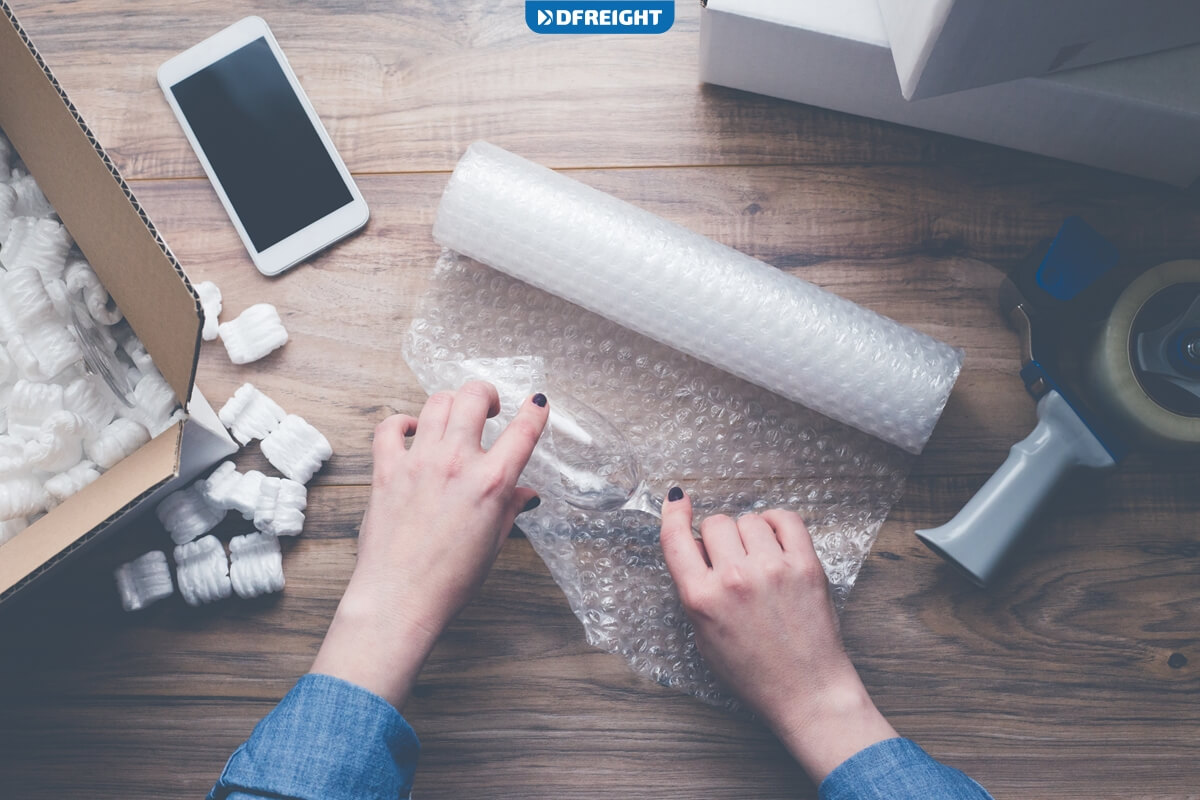Shipping glass sheets and glassware can be challenging due to their fragile nature and susceptibility to damage during transit. DFreight’s experienced team is well-versed in handling fragile cargo and employs best practices for packaging, labeling, and documentation. With DFreight, shipping glass sheets and glassware is made safe and hassle-free, providing peace of mind to customers throughout the entire shipping process.
In this blog post, we will explore the importance of proper shipping methods for glass items and provide valuable insights into choosing the suitable packaging materials, packaging techniques, selecting appropriate shipping methods, documenting and labeling requirements, communicating with shipping service providers, and receiving and inspecting glass shipments. By understanding the unique challenges of shipping glass, we can ensure that these delicate items reach their destination safely and intact.
Table of Contents
Introduction to Shipping Glass Sheets and Glassware
Glass sheets and glassware come in various forms and serve many purposes. Glass sheets are commonly used in construction, architecture, and manufacturing industries, offering transparency, strength, and versatility. They can be found in modern buildings’ windows, doors, partitions, and even as decorative elements. Glassware, on the other hand, refers to a wide range of glass products used for household, hospitality, and decorative purposes. This includes drinking glasses, vases, bowls, and decorative figurines.
Understanding the different types of glass sheets and glassware and their fragility and handling considerations is crucial when shipping these delicate items. By familiarizing ourselves with their characteristics and applications, we can make informed decisions regarding packaging, transportation, and overall care to ensure the safe and secure shipment of glass sheets and glassware.

Choosing the Right Packaging Materials
Choosing suitable packaging materials is of utmost importance when shipping glass sheets and glassware to ensure their protection and minimize the risk of damage. Fragility is a key factor to consider, as glass is prone to breakage during transit. Selecting packaging materials that provide adequate cushioning, shock absorption, and stability is essential. Commonly used packaging materials for glass shipments include bubble wrap, foam inserts, corrugated cardboard, and rigid boxes. These materials offer cushioning and protection against impact while providing stability to prevent movement within the packaging.
Additionally, specialized packaging options such as edge protectors and corner guards can be employed to reinforce vulnerable areas and minimize the risk of breakage. We can create a protective barrier that safeguards glass sheets and glassware throughout their journey by carefully choosing the appropriate packaging materials.
Packaging Techniques for Safe Shipping
Packaging techniques are crucial in ensuring the safe shipping of glass sheets or glassware. Proper preparation and secure packaging are essential to protect these fragile items from potential damage during transit.
Before packaging, cleaning and inspecting the glass for any pre-existing flaws or weaknesses is important.
The glass sheets or glassware should be individually wrapped in bubble wrap or foam inserts to provide cushioning and prevent direct contact between the items.
It is advisable to use dividers or partitions to separate multiple glass pieces within the packaging, reducing the risk of colliding.
Layering techniques, such as interleaving with packing paper or cardboard, can also add extra protection.
Reinforcing the corners and edges of the packaging with corner guards or edge protectors further enhances stability and resistance against impact.
Finally, the packaged glass items should be secured within a sturdy box, ensuring a snug fit and minimizing movement during transportation.
By employing these packaging techniques, we can significantly reduce the chances of damage and ensure the safe arrival of glass sheets or glassware to their destination.
Documenting and Labeling Requirements
Documenting and labeling requirements are crucial aspects of shipping glass sheets and glassware. Proper documentation ensures smooth transit and enables efficient handling of shipments. It is important to accurately document the shipment’s contents, including the glass items’ description, quantity, and any specific handling instructions. This information helps shipping providers understand the nature of the cargo and apply appropriate handling practices.
Additionally, compliance with regulatory requirements, such as customs documentation for international shipments, is essential. Labeling the packages clearly with “Fragile” or “Handle with Care” labels helps alert handlers to the delicate nature of the contents and encourages careful handling. Adhering to any specific labeling guidelines provided by the shipping service provider ensures compliance with their internal procedures and helps minimize the risk of mishandling.
By ensuring accurate documentation and clear labeling, the shipping process for glass sheets or glassware becomes more organized and efficient, reducing the likelihood of damage.
Selecting the Appropriate Shipping Method
Selecting the appropriate shipping method is critical when shipping glass sheets and glassware. The choice of shipping method depends on factors such as the size and weight of the items, the distance to be covered, and the desired delivery timeframe.
Land freight, such as trucks or vans, is a common choice for domestic shipments. It offers a cost-effective option for shorter distances and allows for the careful handling of fragile items.

Air freight offers faster delivery times for urgent shipments or long-distance transportation. However, it may come with higher costs.
Ocean freight is often chosen for international shipments due to its cost-effectiveness for larger quantities and longer transit times.
When selecting a shipping method, it is essential to consider the fragility of glass and the expertise of the shipping provider in handling delicate items. Insurance options and tracking capabilities should also be considered to ensure peace of mind and visibility throughout the shipping process. By carefully assessing these factors, one can choose the most appropriate shipping method that balances cost, time, and the safe transportation of glass sheets or glassware.
Communicating with Shipping Service Providers
Effective communication with shipping service providers is vital when shipping glass sheets and glassware. Researching and selecting reliable shipping providers with experience in handling delicate items is important. Before shipping, clear and detailed communication should take place, highlighting the fragility of the cargo and any special requirements or operating instructions.
Providing accurate and comprehensive information about the glass items, their dimensions, weight, and packaging specifics will help the shipping service provider determine the most appropriate shipping method and ensure proper handling throughout the journey. Regular communication with the provider allows tracking updates and ensures that potential issues or concerns are addressed promptly.
Additionally, discussing insurance options for the shipment can provide added protection and peace of mind. By establishing open lines of communication and fostering a collaborative relationship with the shipping service provider, the chances of successful and secure shipping of glass sheets or glassware are significantly increased.
Shipping Glass Sheets and glassware Safely From/to the UAE
Shipping glass sheets and glassware safely from/to the UAE with DFreight provides a reliable and secure solution. DFreight understands the delicate nature of glass sheets and employs careful handling and packaging techniques to ensure their safe transportation. Their experienced team provides proper protective measures, including using high-quality packaging materials and securing the glass sheets within the shipping containers.
DFreight also collaborates with trusted shipping service providers specializing in fragile cargo, guaranteeing careful handling throughout the journey. With their advanced tracking system, customers can monitor the progress of their shipments and receive real-time updates, providing peace of mind.
Whether shipping glass sheets and glassware from the UAE to other destinations or receiving glass sheets in the UAE, DFreight prioritizes the safe delivery of these fragile items, ensuring customer satisfaction and preserving the integrity of the glass products.
Receiving and Inspecting Glass Sheets
Receiving and inspecting glass sheets is crucial in ensuring their quality and integrity upon arrival. When the shipment of glass sheets is delivered, it is important to carefully unpack and inspect each sheet for any signs of damage or breakage. Start by examining the packaging for visible signs of mishandling or rough handling during transit. Once the sheets are unwrapped, inspect them for cracks, chips, or any other defects under proper lighting conditions. Pay attention to the edges and corners, as these are particularly vulnerable areas.
It is also essential to compare the received quantity with the documented quantity to ensure nothing is missing or damaged. Document any discrepancies or damages by taking photographs and noting them in detail. If any issues are found, promptly contact the shipping service provider to initiate the claim process.
By thoroughly inspecting the glass sheets upon receipt, any damage can be addressed and resolved on time, ensuring customer satisfaction and maintaining the quality of the glass products.
Conclusion
In conclusion, shipping glass sheets and glassware requires meticulous attention to detail, from selecting suitable packaging materials to choosing the appropriate shipping method and effectively communicating with shipping service providers. By following best practices and implementing proper packaging techniques, we can significantly reduce the risk of damage during transit.
DFreight, as a digital freight forwarder with its online platform and mobile app, offers a convenient and reliable solution for shipping glass sheets and glassware. Our expertise in handling fragile cargo and our commitment to safety and efficiency ensure that these delicate items reach their destination intact. By understanding and implementing the necessary precautions throughout the shipping process, we can provide the safe and secure transportation of glass sheets and glassware, preserving their quality and integrity for ultimate customer satisfaction.
How to ship glass sheets?
To safely ship glass sheets, wrap them in bubble wrap, use protective corners, pack them tightly in sturdy crates or boxes, label as fragile, choose a reliable shipping company, and consider insurance.
What is the best shipping method for glass?
The best shipping method for glass depends on various factors such as the glass’s size, quantity, fragility, and destination. It is recommended to consult with shipping professionals or companies like DFreight that are experienced in handling glass to determine the most suitable method for your specific needs.
Can glass sheets be shipped internationally?
Yes, glass sheets can be shipped internationally; however, there may be additional regulations and restrictions depending on the destination country.
Can glassware be safely shipped?
Yes, glassware can be safely shipped if it is properly packaged and handled. Using appropriate packaging materials such as bubble wrap, cardboard dividers, and secure boxes or crates can help protect the glassware from damage during shipping.
How should I package glassware for shipping?
To package glassware for shipping, wrap each piece individually in bubble wrap or foam sleeves. Place them securely in a sturdy box, using dividers to separate each item and prevent them from clashing together. Fill any empty spaces with void fill material to minimize movement.
What precautions should I take to avoid breakage during shipping?
To avoid breakage during shipping, pack fragile glassware items tightly in the center of the box with adequate cushioning material around and between them. Use cautionary labels such as “Fragile” or “Handle with Care” on the package to alert handlers to take extra care during transit.














